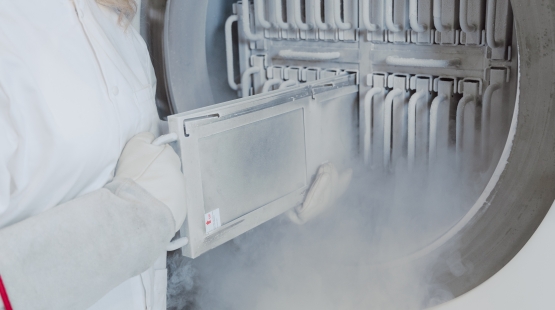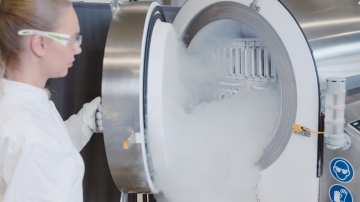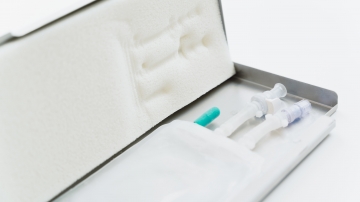Cell cryopreservation preparation process
Table of contents
ShowCryopreservation is a critical procedure that includes the cooling and preservation of frozen cells at extremely low temperatures. This process is fundamental in various scientific and medical applications, facilitating long-term storage without compromising cellular function.
This guide provides an overview of the necessary steps and considerations for preparing cells for cryopreservation. Key topics include selecting appropriate cells, cell culture, harvesting, and storage under controlled conditions, utilizing proper cryoprotective agents, and applying specific freezing techniques.
Selecting the right cells
The selection of appropriate cells for cryopreservation is a foundational step in the process. It begins with the determination of the specific cell type, as different cells have unique requirements for preservation. For example, cryopreserving mammalian cells such as CHO cells or HEK cells may require different protocols and cryoprotective agents compared to preserving bacterial cells or yeast.
Equally critical is the assessment of cell quality. The viability of cells can significantly influence the success rate after thawing. Careful attention to cellular integrity, morphology, and functionality ensures that only high-quality cells are chosen, maximizing the likelihood of preservation success.
The following article focuses on freezing methods for cells or tissues used for biopharmaceutical applications. Other cells, such as oocytes and hepatocytes, are not discussed and often use other freezing techniques, such as vitrification.
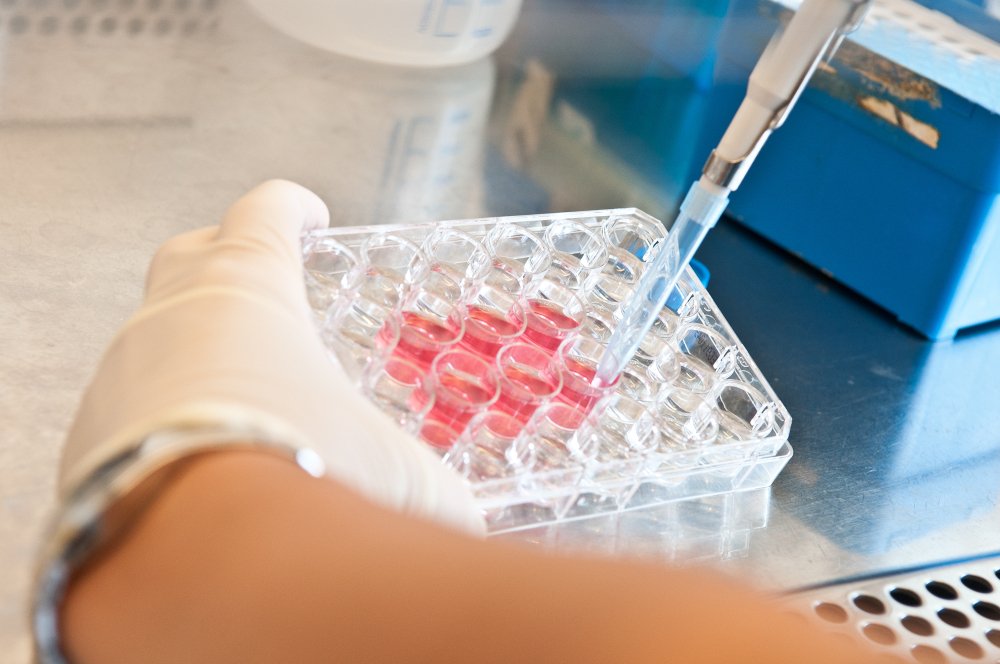
Cell culturing and harvesting
Cell culturing and harvesting are vital preparatory stages for cryopreservation. They encompass the methods and considerations necessary to ensure cells are in the optimal state for freezing.
1. Clinical Applications
Master cell banks (MCBs) provide scientists with access to cell lines. Once a cell line has been identified and characterised, the banked cell can be used for further clinical applications. Cryovials hold a few millilitres of liquid, such as a Corning glass vial. During cell line development, clinical trials can be initiated and cell lines can be cryopreserved. The storage of working cell banks (WCB) in slightly larger volumes makes it easier for scientists to start studies.
2. Cell Culturing
Culturing cells involves growing them in a controlled environment to achieve desired characteristics and cell counts. The procedures vary based on cell type and intended application. For instance, mammalian cells may require specific media composition, temperature, and pH, while bacterial cells might thrive under different conditions. The following are essential considerations in cell culturing:
Media Selection: Choosing the appropriate culture medium with necessary nutrients is crucial for cell growth and maintenance. A typical cell culture media contains a source of energy and other compounds like vitamins, salts and growth factors. Fetal bovine serum is a common serum-containing media for cell culturing.
Environmental Conditions: Temperature, humidity, and CO2 levels must be tightly controlled to support optimal growth.
Monitoring: Regular observation and assessment of cell growth, morphology, and confluence are necessary to ensure they are ready for harvesting.
3. Media Transfer
Cell culture media can be added to support cell growth. In particular, if the aim is to increase cell density, the nutrient media can improve productivity. Which is the case in perfusion cell culture. Here, the continuous media exchange allows for the maintenance of high cell densities and viabilities over extended time.
4. Cell Harvesting
Harvesting is the process of collecting cells from their culture environment in order to prepare them for cryopreservation. This step is quite delicate and demands precision along with strict adherence to established protocols. Typically, the harvesting process involves detaching adherent cells from their growth surface, which can be done using either enzymatic or mechanical methods. After that, centrifugation is used to concentrate the cell suspension. Timing is key during harvesting; it's best to collect the cells while they are in their exponential growth phase to ensure they remain viable and recover well after thawing.
5. Optimization and quality control
Both culturing and harvesting stages require optimization and quality control. It includes tailoring protocols to specific cell types, such as using specialized media for stem cells or adjusting detachment methods for sensitive primary cells. Further, it requires implementing consistent checks for contamination, cell viability, and other quality parameters to maintain integrity.
6. Freezing & thawing
Cell freezing requires great care to maintain cell viability after thawing. Freezing too slowly reduces the likelihood of intracellular ice formation, resulting in cell dehydration & osmotic injury. On the other hand, freezing too quickly will damage cellular structures as the cells are unable to regain equilibrium. A rule of thumb for freezing mammalian cells using a controlled freezing & thawing platform is a freezing rate of approximately -1°C per minute.
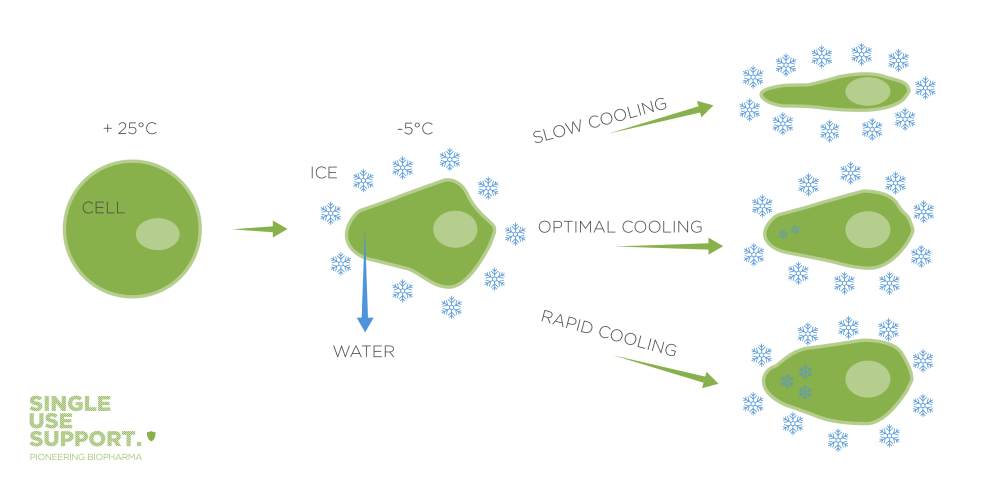
Utilizing the right cryoprotective agents (CPAs)
The primary function of cryoprotective agents (CPAs) is to protect cells from damage caused by ice crystal formation during freezing. Choosing and utilizing the proper CPAs is crucial to ensure that cells maintain their viability and functionality after thawing.
Types of cryoprotective agents
There are several types of CPAs available, each with specific applications and compatibilities:
- Permeating CPAs: These are small molecules that can penetrate the cell membrane. Common examples include Dimethyl Sulfoxide (DMSO) and glycerol. They are typically used for mammalian and other eukaryotic cells.
- Non-permeating CPAs: Larger molecules that do not penetrate the cell membrane, such as sucrose or hydroxyethyl starch, are used alongside permeating CPAs for additional protection.
Different cells may require specific CPAs; for instance, DMSO is commonly used for many mammalian cells. The concentration must be carefully calibrated when added to the liquid, as too much or too little can adversely affect cell viability, and monitoring for toxicity is equally essential. Serum-containing medium used as a reagent for cryopreserved cell suspensions usually contain 10 % glycerol, 10 % dimethyl sulfoxide (DMSO) and cell conditioned media. Serum-free medium often contains up to 7.5% dimethyl sulphoxide and fresh serum-free medium with 10 % cell culture-grade.
1 2 3
By employing carefully selected and optimized CPAs, professionals in the field of cryopreservation can significantly enhance the success rate, ensuring that cells are well-protected during freezing and fully functional upon thawing.
This step, alongside the preceding ones of selecting and preparing the cells, builds a solid foundation for the critical next phase: freezing techniques, where innovations such as solutions from Single Use Support come into play.
Read more: Regulations for Cryoprotectants in ATMP Cryopreservation
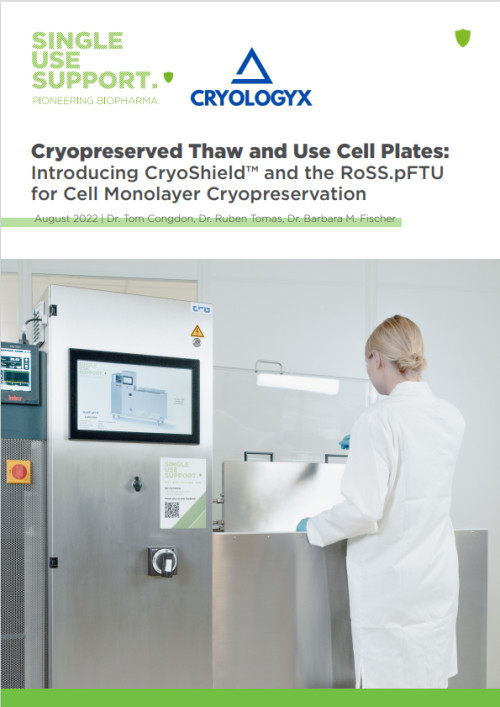
Download App Note
App Note: Cell monolayer cryopreservation
Download the App Note from Single Use Support and CryoLogyx about introducing CryoShield™ (suite of proprietary cryoprotectant materials) and the RoSS.pFTU for cell monolayer cryopreservation.
Freezing Techniques for cryopreservation
Embracing single-use technologies in the cell freezing process has become a best practice in the life sciences field, providing practical and efficient solutions that overcome many challenges associated with traditional methods.
Single-use technologies offer a high level of flexibility in handling a wide variety of cell types and volumes. Single Use Support has established a product line-up that accompanies the cell freezing process, with tools like a homogenizer and a filling solution capable of portioning even tiny amounts of cells gentle and homogenous into single-use bags.
RoSS.PADL is a platform for homogenizing and cooling cells in single-use bags that enables consistent cell counts in aliquoted single-use bags. The cooling helps cells to reduce temperature before and automated filling with RoSS.FILL into single-use bioprocess containers. Homogenizing & cooling cells supports cryoprotectant equilibration but also reduces cell death during the time at room temperature after the addition of CPAs. Cells filled into single-use bioprocessing containers and covered by protective shells can then undergo controlled freezing.
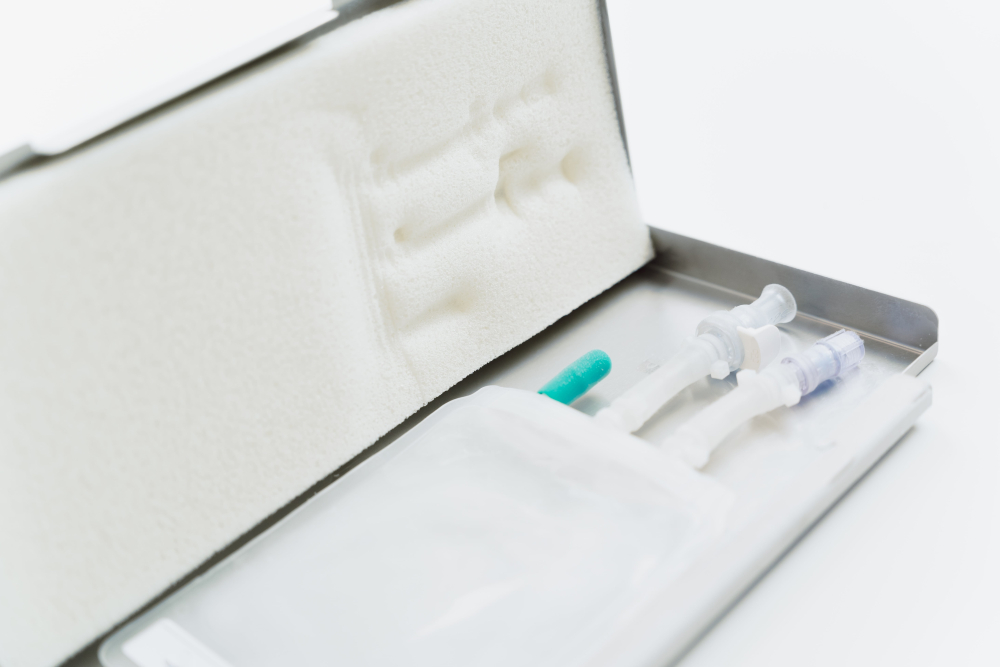
Freezing to -80°C
With the plate-based freezing platform RoSS.pFTU cells can be frozen down to -80°C / -112°F in a controlled process. This method offers uniformity and precise control over the freezing process, allowing for the preservation of various cell types. With the ability to handle different volumes and the inclusion of homogenizers and filling solutions, our solutions address the specific needs of flexibility and automation in diverse research projects.
At -80°C or -112°F, the frozen single-use bags can be used for further cryogenic storage.
Cryogenic Freezing to -170°C
The cryogenic controlled rate freezer solution from Single Use Support is unique in offering truly controlled-rate freezing using liquid nitrogen, capable of reaching temperatures as low as -170°C / -274°F.
Single Use Support’s innovative solutions reflect the best practices in cell freezing. Both the plate-based freezing platform and RoSS.LN2F system not only overcome challenges associated with traditional freezing methods like inconsistent freezing rates, limited scalability or lack of flexibility, but also provide greater control, uniformity, and adaptability.
Read more about cryogenic freezing in the article: Cryogenic freezing - All you need to know.
Conclusion
In the rapidly advancing realm of life sciences, the ability to preserve cells effectively for later use is paramount. As explored in this article, the processes of selecting cells, using appropriate cryoprotective agents, and leveraging innovative freezing techniques are all vital components of this procedure. Single-use technologies, like those of Single Use Support, stand at the forefront of these advancements, offering solutions that improve the quality of cells post-thaw.
Read more about cryopreservation
- Diverse effects of dimethyl sulfoxide (DMSO) on the differentiation potential of human embryonic stem cells, http://dx.doi.org/10.1007/s00204-011-0782-2, Published 2011-11-21
- Cryopreservation and its clinical applications, http://dx.doi.org/10.1016/j.imr.2016.12.001, Published 2017-01-10
- , Published



